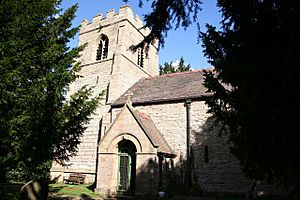St Nicholas' Church, Hockerton facts for kids
Quick facts for kids St Nicholas' Church, Hockerton |
|
|---|---|

St Nicholas' Church, Hockerton
|
|
| 53°6′1.0″N 0°55′56.6″W / 53.100278°N 0.932389°W | |
| OS grid reference | SK 71596 56445 |
| Location | Hockerton |
| Country | England |
| Denomination | Church of England |
| History | |
| Dedication | St Nicholas |
| Architecture | |
| Heritage designation | Grade II* listed |
| Administration | |
| Parish | Kirklington with Hockerton |
| Deanery | Newark and Southwell |
| Archdeaconry | Newark |
| Diocese | Diocese of Southwell and Nottingham |
St Nicholas' Church is a very old church located in the village of Hockerton, England. It is a special building because it is listed as a Grade II* listed building. This means it is an important historical building that needs to be protected. The church used to be a place of worship for the Church of England, but it is now considered a "redundant" church, meaning it is no longer used for regular services.
A Look at the Church's History
This church has been around for a very long time! It was first built in the 12th century. That means it is over 800 years old. Imagine all the history it has seen!
Important Changes Over Time
In 1876, the church underwent a big change. It was "restored" by an architect named Charles Hodgson Fowler. This means parts of the church were repaired and updated to make sure it stayed in good condition.
For some time, St Nicholas' Church was part of a "joint parish" with another church, St Swithun's Church, Kirklington. A parish is like a local area that a church serves. Being in a joint parish meant they shared some duties and responsibilities.
When the Church Closed
Sadly, in 2016, St Nicholas' Church was closed for worship. This means it stopped holding regular church services. Even though it's no longer used for worship, it remains an important historical landmark in Hockerton.

